Text
WHAT I HAVE LEARNT
CATEGORY 5: THE EXTRATERRESTRIAL
The design of the extraterrestrial is by far the most imaginative source of artist interpretation that I have researched into whilst writing this blog. Unlike folkloric tales and the paranormal, which often produce visual stimuli based on historic accounts and descriptions. The role of the extraterrestrial in artistic design relies heavily on conscious artist interpretation rather than historic or mythical descriptions. Whilst some have reported the ‘discoveries’ of alien craft and extraterrestrial life, the majority of the human population have not payed witness to an extraterrestrial encounter. This being said, it appears that the majority of artist interpretation in film and illustrative media lend ideas from depictions that were generated previously. The standard interpretation of an alien is well known to most, and so to alleviate the problem of repetitive design across creative media, a number of interpretations have a tendency to create unique alien designs to provide contrast from the stereotypical conception.
UFO’s on the other hand, through the use of photography (regardless of the photograph’s authenticity), have provided a more influential design into the appearance of extraterrestrial craft. Often reflecting the common flying saucer that is entwined in Extraterrestrial American culture.
Overall I find the role of the extraterrestrial has impacted greatly on artistic design and interpretation. Many scientific films utilise concept art based on extraterrestrial life and space craft, focussing mainly on the artist’s imagination and design of aesthetic characteristics. When drawing the unknown in the form of extraterrestrial matters, it appears that artist interoperation is more accepting of variation as there is not definite description as to what extraterrestrial life, or space craft would look like. Thus creating an array of depictions whilst acknowledging a stereotypical alien design.
1 note
·
View note
Photo
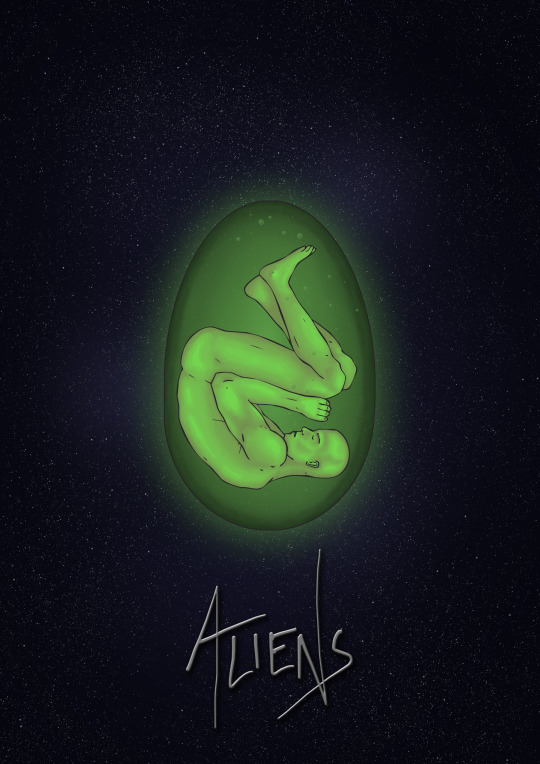
CATEGORY 5: THE EXTRATERRESTRIAL (VIII)
Probe
I created this image based on a number of ideologies that I stumbled across whilst researching into this category. I didn’t focus the design of this drawing on any specific alien association or interpretation however. Instead I decided to focus on something different that branched away from the common themes surrounding the extraterrestrial. The idea of human probing conduction by alien life gave me inspiration for this design, which lead me to this abstract interpretation. The use of the colour green reflects the common association of this colour with alien life.
0 notes
Photo




CATEGORY 5: THE EXTRATERRESTRIAL (VII)
Alien Invasion of the Media
The role of the extraterrestrial, and more specifically aliens, has played an influential role on various forms of media over the years. The four images above all represent different interpretations of an alien for three different audiences.
The first image depicts an alien from the Disney Pixar film ‘Toy Story’. This alien retains the green coloured skin often associated with aliens, but contrasts facially with the inclusion of a third eye. The primary audience for this film are children, and so the creators of this alien have amplified the friendly looking approach by incorporating the design into a toy. This alien appears quite stocky and short, as a toy would, but doesn't incorporate some of the more sinister interpretations that we associate with aliens, notable the large, dark eyes.
These sinister characteristics are highly prominent in the second and third images however, representing aliens from the ‘Alien’ franchise and ‘War of the Worlds’ 2005 movie respectively. Both of which are aimed at a more mature, adult and young-adult audience. These aliens depict unique characteristics that are not generally associated with conceptualised aliens. The alien in the second image appears all black in colouration, adding to the malevolent demeanour that the creature posses. Although humanoid in form, this alien, known as a Xenomorph, is far from human in design when bearing reference to the creature’s head and external limbs. The third image from the science fiction disaster film ‘War of the Worlds’ depicts a different translation of an alien that walks on four limbs as opposed to two. This alien retains the dark, black eyes that are associated with aliens, but the head and body of the alien overall is very different in style and interpretation.
The fourth and final image represents a scene from 1999 pinball machine ‘Revenge from Mars’. These aliens are coloured in green and appear humanoid in appearance like many alien interpretations. The only difference here being the inclusion of two extra libs on either side of the alien’s torso to produce 4 working arms.
When comparing the four specimens of alien interpretation above, I find the aliens in the fourth image the most interesting in design. Nostalgic reasoning aside, these aliens incorporate a complex design that draws influence from common interpretations whilst merging with original aesthetic features unique to the game. It is interesting to note however that all the aliens above appear identical when compared to another alien in that franchise, film, or game. The obvious visual examples of this lies in the second and fourth image, where all the aliens appear identical, with the exception of the larger alien in the fourth image. This being said, a common interpretation of an alien is the concept of singularity. The majority, if not all alien and extraterrestrial interpretations focus on identical alien designs for all aliens in that given film, comic book, or game.
All in all, the overall design of extraterrestrial life in artist interpretation appears to vary depending on the intended audience or artistic style applied, often drawing reference from stereotypical alien designs. Yet the design of characteristics between aliens that appear in the same franchise appear almost identical.
Image Sources:
http://vignette4.wikia.nocookie.net/pixar/images/a/ae/Alien.jpg
http://static.comicvine.com/uploads/original/3/38826/877172-alienwarrior.jpg
http://listfan.xyz/wp-content/uploads/attack-from-mars-5.png
http://4.bp.blogspot.com/-2Pct27oYRwg/UUJi3BGxH2I/AAAAAAAAG1c/r1dtt0f_pGc/s1600/aaronsimscompany+artwork.jpg
1 note
·
View note
Photo



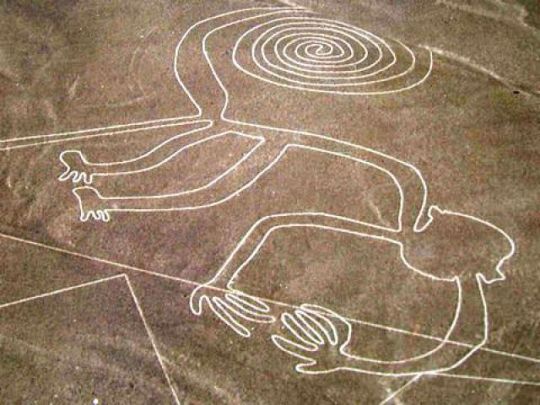

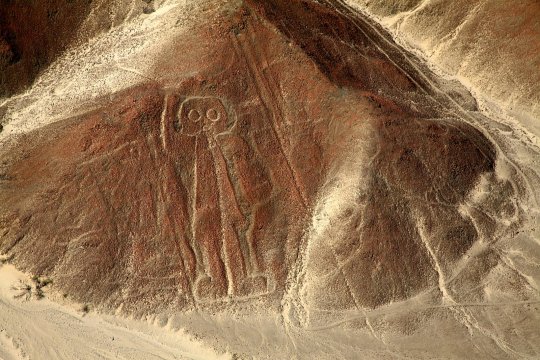
CATEGORY 5: THE EXTRATERRESTRIAL (VI)
The Nazca Lines
The Nazca lines are a fascinating sight that lie in the Nazca desert in southern Peru. Not only are these works of artist interesting visually, but they are unique in the sense that they can only be seen in their true forms from high above the ground. Preserved by the isolation and dryness of the desert in which they reside, the Nazca Lines have existed for over one thousand years and still intrigue the minds of many as to their original purpose. Some historians believe that the lines were created by the Nazca people as an offering to their gods, who could look down from the heavens and bear witness to them. Others have theorised that the purpose of the lines lies with the concept surrounding communication with extraterrestrial beings.
Whatever their purpose, I have chosen to incorporate the Nazca Lines into this category due to their hypothetical link with the extraterrestrial. Which is interesting, as one of the lines is believed to depict an astronaut. This depiction illustrates a figure with an unusually round head and very large eyes. Two common traits associated with alien appearance. The figures right hand points towards the sky, which some believe is an insight into the previous encounter with extraterrestrial life.
Personally, I find the Nazca lines extremely interesting. Not only in their design, but also in their visualisation method. The lines are seen best when looking from directly above, but the mountains to the north and east provide a little insight into the lines’ overall appearance above ground. Despite their huge size, the lines appear to have been created very accurately, with all lines running smoothly and in some instances, directly parallel to one another.
Image Sources:
http://www.greentracks.com/images/Nazca/spider.jpg
http://www.redicecreations.com/ul_img/24592nazca_bird.jpg
http://beforeitsnews.com/contributor/upload/30080/images/lines4.jpg
http://monumentalloss.com/wp-content/uploads/2013/07/Nazcan11.jpg
http://www.go2peru.com/images/naz_mapa_lineas.jpg
http://www.personal.psu.edu/users/s/a/sai5053/IMG_0090.jpg
2 notes
·
View notes
Photo
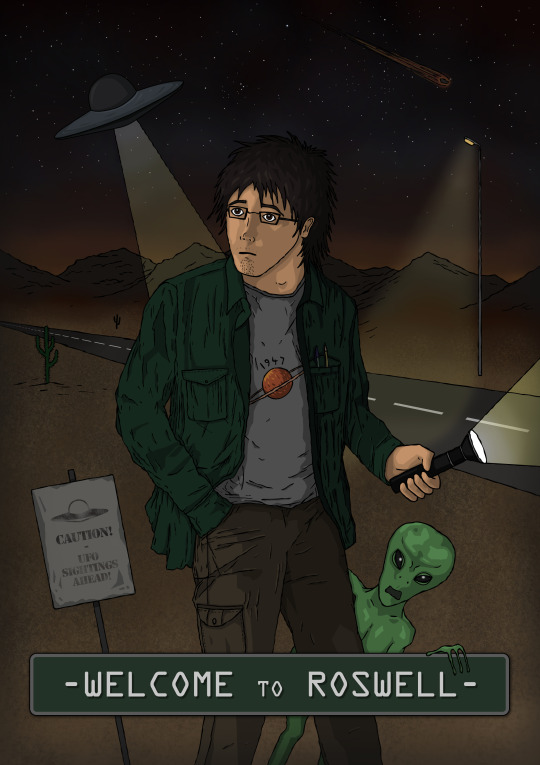
CATEGORY 5: THE EXTRATERRESTRIAL (V)
The Roswell Incident
After researching into artist interpretations of various alien encounters, I decided to create an image of my own which draws influences from the 1947 Roswell Incident. In the July of 1947 a local sheep rancher reported the crash landing of an unknown craft after the events of a thunder storm. The debris from the crash was quickly accumulated a day later when the local newspaper published a report on the ‘capture’ of ‘a flying disc’. The US Government later disclosed that the aircraft was in fact a surveillance balloon that had crashed during the storm. Many conspiracies have since emerged relating to the Roswell Incident, and to this day is believed to be one of the biggest cover-ups by the US Government.
When designing the layout for this piece, I drew inspiration from several stereotypical Roswell related gimmicks. The inclusion of the UFO and the alien come from the suspected UFO crash at this sight. The green alien itself drawing characteristics from common interpretations of grey and green aliens. The year and the planet on the character’s shirt relate to the year of the incident and the association with outer space respectively. The scene is set in a typical south-western American desert not too similar to those that surround the town of Roswell.
It is interesting to note that the crash of 1947 has greatly influenced the culture of Roswell, becoming a highly visited tourist attraction and even incorporating a visual interpretation of an alien into the town’s official seal.

Image Source:
https://en.wikipedia.org/wiki/Roswell,_New_Mexico
29 notes
·
View notes
Photo

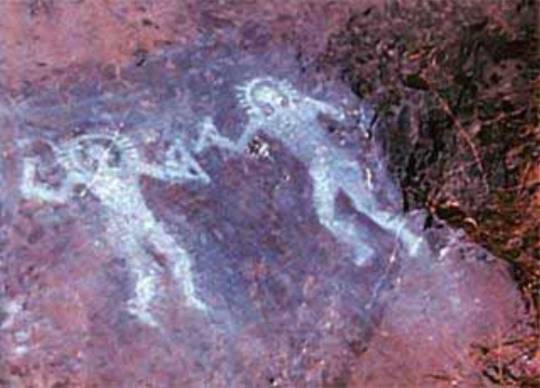
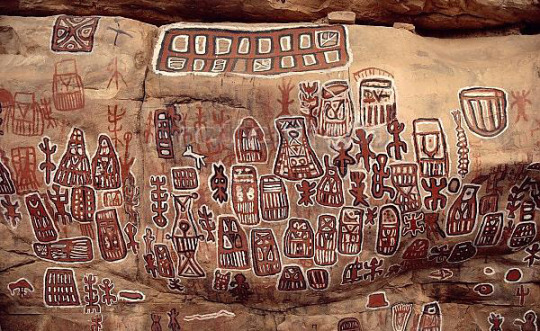

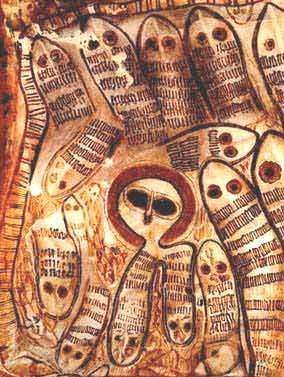
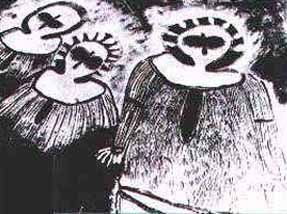

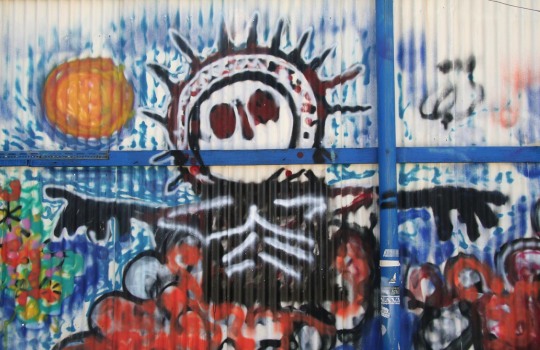
CATEGORY 5: THE EXTRATERRESTRIAL (IV)
Ancient Aliens
Cave art and rock paintings have been discovered across number of ancient sites where locals would decorate the inside of caves with vivid depictions. The majority of these depictions focused on the natural environment. Encompassing animals, such as horses and cattle, alongside images of neanderthals hunting into one large image that stretched across the cave walls. A number of cave paintings discovered have depicted rather strange and unusual depictions that do not match animals and humans that are easily identifiable. Now some cave paintings, notably those in the Northern Hemisphere, have depicted extinct animals such as the Mammoth. Although the Mammoth no longer exists, we are aware of its presence in history and can identify cave paintings depicting this large animal as a Mammoth. Other depictions are less recognisable however and have left the founders of these caves paintings with a question mark resting above their heads.
Val Camonica
The first and second images are both cave paintings from the North Italian valley of Val Camonica. Both of these archaic paintings look substantially different from cave paintings that we are usually accustomed to.
The first image does not represent a photograph taken of the cave paintings like the other images that I have gathered. Instead this image appears to have been edited to provide a contrast between the darker coloured paint and the lighter coloured background. Nevertheless, the two humanoid-like figures in the centre of this piece bear a resemblance to the common grey alien conception facially, rather than of a human.
The second image clearly depicts two humanoid figures, although they appear to be wearing space helmets associated with astronauts. A concept developed thousands of years after the creation of these paintings. The figures can also be seen holding something in their hands, a tool or device which bears no resemblance to other ancient instruments.
The Bandiagara Escarpment
The Dogon people native to this region of Mali, Africa, have attracted the curiosity of many an astronomer in recent years due to their pre-cognition relating to the stars and other celestial bodies. The Dogon creation myth states that a race of extraterrestrial people, known as the Nommos, visited Earth many thousand of years ago from the Sirius Star system. The Dogon claim that the Nommos presented them with a vast source of knowledge relating to the astronomical features of the sky. Gaining a knowledge and understanding of various celestial bodies before they were discovered by Western astronomers and scientists. The third image depicts a number of rock paintings produced by the Dogon which some believe me recall the existence of extraterrestrial life. I find these paintings most interesting due to their bold outlines that heavily defines their character.
Tassili N’Ajjer Park
The Sahara Desert is famed for its archaeological discoveries, providing thousands of ancient sites that reveal the illustrated life of Earth’s peoples and its past. The Tassili N’Ajjer Park is no exception to the rule, administering an insight into life dating back to Neolithic times when the area was likely to have been a savannah rather than a desert. A number of cave paintings, including the fourth image above, appear to depict what is believed to be an ancient astronaut. Many of the depictions interestingly appear to wear clothing typically associated with modern day astronauts, most notably the inclusion of a space helmet. The image above depicts the figure with a dome shaped head with various lines traveling across the cranium. With two circular holes that appear to be eyes. Some have theorised the dome is in fact as space helmet worn by an astronaut believed to be of extraterrestrial origin.
The Wandjina
The fifth, sixth, and seventh images are my favourite interpretations of cave paintings that I have discovered relating to possible extraterrestrial life. My curiosity does question their authenticity, but for that reason alone I find them incredibly interesting. These rock paintings originate from Kimberley, in Western Australia. According to Aboriginal mythology, the paintings were created by the Wandjina, powerful cloud and rain spirits charged with maintaining the Earth’s fertility. The Wandjina, who are depicted on the rock walls all have a pair of eyes, a nose, yet no mouth. The exclusion of the mouth relates to Aboriginal mythology, creating a bizarre, yet strangely fascinating interpretation of extraterrestrial life. In 2007, the Wandjina caught the eye of the Australian public, with many Wandjina drawings appearing as graffiti or street art scattered across the streets of Perth, Western Australia. The eighth image represents a street art interpretation of the Wandjina rock paintings, drawing reference from the spirits’ original design whilst incorporating subtle newer details such as the spikes around the head.
Extraterrestrial Art?
The role of the extraterrestrial and its influence over ancient and traditional art forms is a curious and interesting predicament to say the least. Whilst the majority of art depictions on rock and cave walls can be translated by contemporary understandings, the lack of knowledge towards other paintings I find interesting. It would appear from the images above as a visual source of evidence that contemporary interpretations of alien life share characteristics present within the drawings of our ancestors. The concept of large eyes seems to be a common theme in the drawings above, most notably the eyes of the Wandjina. With common interpretations of grey aliens possessing large and intimidating black eyes. Whether these drawings do or do not represent encounters with extraterrestrial life, they do depict unusual styled humanoid figures that still leave this question unanswered. If these paintings are not extraterrestrial of origin, then what are they?
The website below provides some more interesting images and information relating to extraterrestrial life integrated into art history that I have not discussed above.
http://www.crystalinks.com/ufohistory.html
Image Sources:
http://www.crystalinks.com/ufohistory.html
https://algorhythym.files.wordpress.com/2011/08/07.jpg
http://www.mediastorehouse.com/p/249/dogon-cave-paintings-1599791.jpg
http://www.crystalinks.com/ufo6000.jpg
http://i89.servimg.com/u/f89/12/39/22/02/ufo11_13.jpg
http://press.anu.edu.au/hrj/2009_02/images/Figure10.14
Book Source:
Supernatural: The World Guide to Mysterious Places (by Sarah Bartlett)
1 note
·
View note
Photo
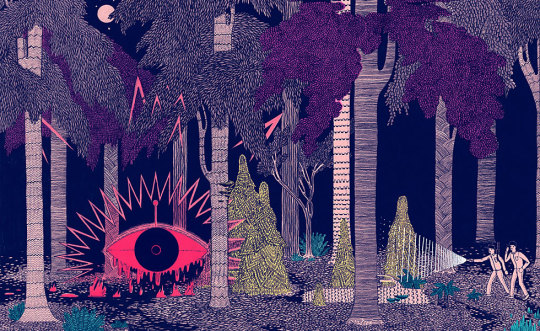

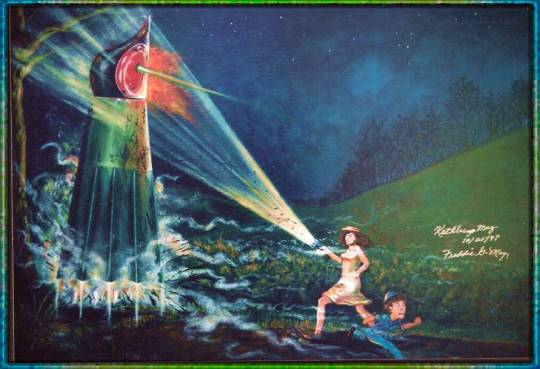

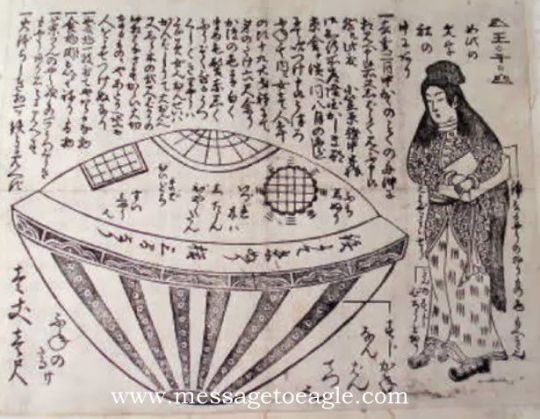
CATEGORY 5: THE EXTRATERRESTRIAL (III)
Alien Encounters
There have been reports of alien encounters across all continents of the globe, with exception of Antarctica. ‘Encounters’ with what are generally accepted to be other-worldly entities have impacted on various cultures and civilisations since recordings of extraterrestrial beings have been discovered. Unusual cave drawings found in sparsely populated areas of the world have been found to depict unusually figured humanoids that some believe are ancient interpretations of aliens. I will discuss these types of drawings in the next blog entry relating to how extraterrestrial beings may have influenced archaic art depictions. As for this blog entry I will focus solely on more contemporary interpretations of what is believed to be extraterrestrial activity.
The Rendlesham Forest Incident
The first of the five images above represents the Rendlesham Forest Incident that occurred in the December of 1980. This piece was created by American artist, Micah Lidberg. I find this piece interesting in design when compared to other depictions of UFO encounters. The majority of UFO artist interpretations will encourage a photo-realistic style to their art in an attempt to make their piece look all that more convincing, as photographical evidence is one of the, if not most important medium as to prove the existence of UFO’s. Lidberg’s interpretation is interesting as it applies a cartoon styled effect to an alleged event. Lidberg’s interpretation portrays an encounter of the second kind, and as such no alien life is present in this image. Despite this however, Lidberg’s UFO appears similar in design to the traditional flying saucer, yet appears more like a human eye glaring at the viewer. Lidberg’s depiction of this event is one of my favourite artist interpretations of an alien encounter as I find his style reflects a different sense of understanding into common perceptions of alien life.
The Skies of Nuremberg
The second image takes us away from 1980′s England and to 16th Century Nuremberg where local citizens were astounded by the events that lit the sky just above them. Reflecting the nature of its time, this image was produced by German printmaker, Hans Glaser. To those unaware of the story surrounding this piece, you wouldn’t be mistaken into thinking that this image represented something other than an alien encounter. Initially I thought that this piece reflected something of a religious nature due to the high frequency of crosses present. As it turns out, my initial thought wasn’t too far from the beaten track. Glaser chose to incorporate a number of crosses into the sky of this piece as citizens on the ground below believed that the display of lights was a strange act of God intended to persecute sinners. Similarly to the first image, this image represents a close encounter of the second kind, as no animated figure of an alien is present. There are in fact UFO’s decorating the sky however. Where? you might ask. The long cylinders in this image were believed to be UFO’s travelling across the sky, realising spheres of colour, rods, and crosses into the sky to which those below were witness. Glaser’s depiction of a UFO appeared long before the conception of the flying saucer, and thus was not influenced at all by this design. This is interesting to note, as this may be one of the few images produced before the traditional Americanised UFO depiction that does not reference a UFO as a flying saucer.
The Flatwoods Monster
The third and fourth images represent artists’ interpretations of the Flatwoods Monster which is believed to be a close encounter of the third kind. I find the constant similarity in design between theses two images intriguing as it would suggest that one is more or less a translation of the other. With the third image likely to be the translation of the original. The third image showcases a very colourful interpretation of the monster being observed by Kathlyn May, who was believed to have first gave witness the creature. The monster itself appears very imaginative in design, completely defying common interpretations such as grey and green aliens. Due to this interesting blend of aesthetic qualities, the monster and its interpretation has subsequently integrated itself into a number of video games.
Harashagahama
The firth and final image depicts an alien encounter during the spring of 1803 in the Japanese village of Harashagahama. This image depicts a simple pen and ink drawing of the alien craft which many locals reported drifting along the waves towards the shore. The tale includes the sighting of a young woman with red hair and pale skin emerging from the vessel, although it is unclear if the woman pictured in the image is the young alien woman or a bystander. The only clue to the woman’s origin being the darker coloured hair in conjunction to the alien’s red hair. Suggesting that the woman in this picture is in fact a witness to the event. In appearance, the alien craft presents itself as a saucer shaped vessel, similar in description to the classic flying saucer.
After researching into the four historic encounters above, it is clear that each interpretation of each respective event recalls the scene in the artist’s distinctive style. There appears to be notable similarity between the depictions of the alien craft in the first and fifth images, each of them appearing to represent a flying saucer. Whilst the second image of the Nuremberg sky depicts cylinder-like vessels instead. The role of artist imagination has a heavy influence over drawing the unknown in the form of alien encounters. These extraterrestrial encounters, until proven otherwise, are primarily an enchanting form of fiction that ignites the imagination through means of curiosity.
Image Sources:
http://idsgn.org/images/fresh-and-hungry/micahlidberg2__full.jpg
https://upload.wikimedia.org/wikipedia/commons/f/f1/Himmelserscheinung_über_Nürnberg_vom_14._April_1561.jpg
http://flatwoodsmonster.com/monsterinmaypainting-rev2.jpg
https://upload.wikimedia.org/wikipedia/en/5/50/Flatwoods_monster.gif
https://s-media-cache-ak0.pinimg.com/736x/50/d0/08/50d0086646ffced9c0d18aeb7a9afbde.jpg
Artist Link:
MICAH LIDBERG: http://www.micahlidberg.com
Book Source:
Supernatural: The World Guide to Mysterious Places (by Sarah Bartlett)
#drawingtheunknown#the extraterrestrial#art#alien encounters#Rendlesham Forest#Nuremberg#flatwoods monster#Harashagahama
1 note
·
View note
Photo

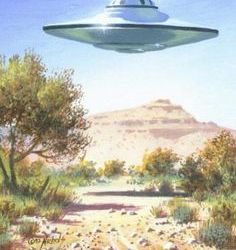
CATEGORY 5: THE EXTRATERRESTRIAL (II)
Unidentified Flying Objects
Artist interpretations of alien craft, or more specifically UFO’s, have a tendency to be very generic in design and composition. Since the 1950′s, when UFO sightings became increasingly popular in the US, the common interpretation of a UFO described a flying saucer like disc that would rotate in the sky. This depiction is often regarded as a general observation of what a UFO would, or should, look like. With many hoax photographs and artist depictions favouring disc-shaped craft in their images as opposed to air craft notable in appearance to military design.
The two images above, produced by unnamed artists, depict two interpretations of a UFO hovering above the ground. It is clear from both of these images that the inspiration from these pieces can trace their influences back to the same source. UFO’s are usually depicted as being dark, grey, or metallic in colour and design, often releasing a beam of light from the base of the craft that points straight to the ground. This description is identical to portray of the UFO in the first image which incorporates all the stereotypical gimmicks and associations with a UFO into a single image. The second image, too, follows this formula. Albeit it that the time of that day depicted by the lighter colours and light blue of the sky has rendered the artist’s decision to not include a beam of light extending from the craft. The only remaining common feature not present in either of these pieces is the inclusion of flashing lights that decorate the craft’s exterior. Although I feel that in this instance, the respective artists of each of these pieces had purposely chosen not to include flashing lights for the purpose of the surrounding environment and colour scheme present.
Both of these images, along with the majority of UFO interpretations that can be found on the internet bear a resemblance to UFO depictions that have integrated their way into American culture. The flying saucer is an example that traditional symbolism has affected the way in which artists draw the unknown in the form of UFO’s and other extraterrestrial space craft. And although artist interpretations of alien craft relating to comic books and film have advanced greatly aesthetically over time, the original flying saucer depiction is widely regarded as the most well known UFO portrayal.
Image Sources:
http://poolga.com/shared/images/poolgas/ipad3_1444.jpg
https://s-media-cache-ak0.pinimg.com/236x/dd/88/65/dd88654fe714880031811f79e6f8ad78.jpg
1 note
·
View note
Photo


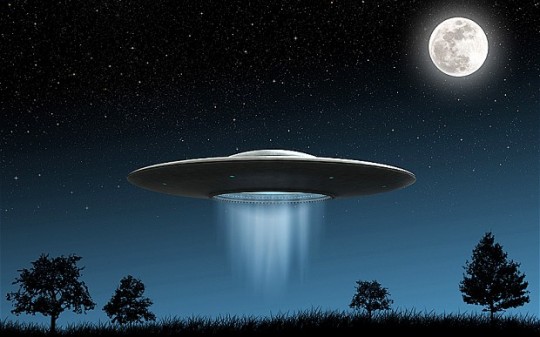
CATEGORY 5: THE EXTRATERRESTRIAL (I)
Foreign by Name, Foreign by Nature
The concept of life living beyond the enriching and nourishing environment of our home planet has long dwelled upon the minds of many a scientist and astronomer, who believe that such conditions exist in our universe to support and sustain life beyond the lush, terrestrial habitats present here on Earth.
Encounters with these supposed extraterrestrial beings has been limited to conveniently timed photography, often blurry and not providing enough detail to engage in accurate interpretation. This hasn’t stopped the large amounts of interpretations of these other worldly entities from exploding into creative mediums such as comic book illustrations and film, however.
The word alien derives from the Latin, ‘alienus’, relating to someone or something that is of foreign origin or not belonging to another’s home environment. In this fifth and final category, I will explore the relationship that art has with the uncertainty that lies above sky and how this these conceptions have moulded contemporary interpretations of the creatures we call ‘aliens’.
I will focus primarily on topics surrounding the subjects below:
Artist interpretations’ of alien life (Common conceptions including greys and green aliens).
Artist interpretations’ of alien craft, including UFO sightings and misleading visuals of the night sky.
Alien encounters.
Ancient Astronomers and Ancient Aliens, focusing on archaic cave drawings and illustrations produced thousands of years in the past.
Theorised Extraterrestrial presence on Earth with links to art and design. And,
Movie interpretations of the extraterrestrial.
Although the role of extraterrestrial beings has rarely imprecated on folkloric traditions relating to human civilisation, some scholars have theorised potential links between ancient customs surrounding the creation of humankind and the world with contemporary understanding of extraterrestrial life. This connection is apparent mainly through the aesthetic distribution within these folkloric tails, with some descriptions bearing a great resemblance to the stereotypical depiction of an alien. I will bear reference to these art pieces in relation to the subjects above, yet it is interesting how the role of art has lead many to establish relationships with what is believed to exist beyond Earth.
Image Sources:
http://www.clker.com/cliparts/0/4/c/0/11971075031983862310laurent_little_green_alien.svg.hi.png
http://www.boudillion.com/lam/greyalien02.gif
http://i.telegraph.co.uk/multimedia/archive/02387/ufo_2387810b.jpg
1 note
·
View note
Text
WHAT I HAVE LEARNT
CATEGORY 4: THE PARANORMAL
Unlike the tales of folklore that have transcended from generation to generation over the years, the role of the paranormal and it’s inclusion of sightings has produced a more varied impact on artist interpretations’.
General observations of ghosts for example will often depict a ghost in one of two distinctive styles. Either representing the symbolic, white sheet ghost or the historical interpretation of a ghost that appears almost human-like in appearance. Artistic interpretations’ of the paranormal are not as common as other art forms depicting unknown subjects such as those originating from folklore or extinct species. As a result of this, interpretations of paranormal phenomena, such as ghosts and human auras amongst a few have a tendency to lend their design and interpretation to previous depictions.
The paranormal and it’s prevalence in fiction appears to have a greater influence on artistic design relating to this subject. Famed novels and short stories such as ‘The Legend of Sleepy Hollow’ and ‘A Christmas Carol’ have characterised the ghosts in each of their respective novels into distinguishable representations of the paranormal that we can easily recognise, with a pre-existant understanding of the novel.
After researching into this area over the past week, it became clear to me that the role of the paranormal has less of an influence over independent art pieces. Instead, the majority of art pieces depicting paranormal ideologies and entities are based upon fictional stories and tales relating to the characters and locations linked to them.
0 notes
Photo


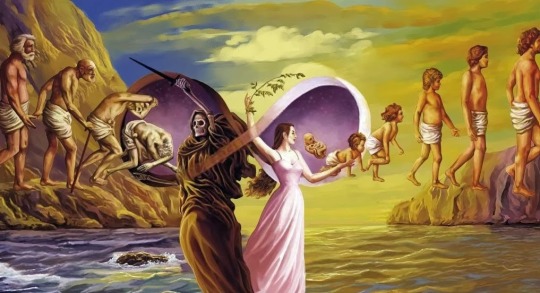


CATEGORY 4: THE PARANORMAL (VIII)
Mind vs. Matter
The last areas of discussion that I will be researching under this category centre around the themes of:
Out-of-body experience
Reincarnation
Life after death, and
ESP (Extrasensory perception)
Artist interpretation into these areas of discussion are rather vague and sparse in production, with obvious reason. Therefore I have decided to quickly analyse the few interpretations that I have gathered to sum up the rest of this category.
The first and second images represent an artist’s interpretation of an out-of-body experience where the soul is believed to temporarily leave the body through means of astral projection. The patchy, cloud-like background is used to represent the aesthetic of a dream-like state that is distant from reality. In these images, the artist has incorporated the link between the soul and the body through the use of a thin line which those who have engaged with the phenomena have often described. Those who have experienced an out-of-body experience will often report witnessing their own body being distant from them, a trait which the second image has emphasised.
The third image depicts the religious conception of Reincarnation, in which the soul does not die after death, instead continuing life again in a new body. This image incorporates the common interpretations of life and death, coercing the dying body of one to be reborn into the new body of another. Effectively ending death’s hold over the mortality of the soul.
The fourth image represents the common depiction of life after death, or a near-death experience. Those who have claimed to have bared witness to this phenomena have often reported the well-known light at the end of the dark tunnel imagery that the majority of us a familiar with. The artist’s rendition of this imagery perceives the individual as a silhouette drawing close to the end of the tunnel, although it has been speculated that deceased relatives and friends of the individual are sometimes known to appear.
The fifth and final image is an artist’s interpretation based loosely on the cognitive ideology surrounding Extrasensory perception (ESP). ESP is often considered to be a rare sixth sense to those who are believed to posses the ability. In which an individual can gather information of his or her surroundings without the use of physical senses, instead sensing stimuli solely with the power of the mind. Due to this understanding, those believed to have ESP are often considered to be psychic, and thus the few art works produced depicting the phenomena will often centre around the portrayal of the human mind in relation the sensory reception of this vital organ. The depiction of this phenomena is more or less highly stereotypical in design, incorporating the design of a computer circuitboard into background to reflect the brain’s higher processing power combined with a 3D depiction of a human head.
Unfortunately, artist interpretations’ into these areas are limited in design and are usually overlooked in comparison to the other paranormal depictions, such as ghosts for example. Despite this however, depictions in these areas almost exclusively replicate one another in design and provide little contrast between ideology.
Image Sources:
http://photos2.meetupstatic.com/photos/event/c/d/5/f/highres_19672575.jpeg
http://aroundthecabin.com/wp-content/uploads/2014/12/obe.jpg
http://www.spiritscienceandmetaphysics.com/wp-content/uploads/2015/01/reincarnation-21.jpg
http://www.independent.co.uk/incoming/article8942556.ece/binary/original/afterlife2.jpg
https://indrajitrathore.files.wordpress.com/2013/09/esp-2.jpg
1 note
·
View note
Photo


CATEGORY 4: THE PARANORMAL (VII)
The Human Aura
The concept of a human aura, or spiritual field encasing the human body has long intrigued people to the unexplained and unseen forces surrounding the human body. The proposed ideology behind the human aura can locate its routes nestled within many religions, with notable religious figures such as Mary in Christianity, and Shiva in Hinduism often pictured with a glowing aura surrounding them. The glow of an aura provides an un-earthly appearance to those they surround, often emphasised by their power and authority over ordinary people.
The idea of the aura being a part of every individual is also a prevalent feature in a number of religious, and sometimes medical procedures. Notably those originating from South-East Asia. The inclusion of colour into the human aura is a common interpretation as to what the human aura, if existent, is believed to look like. Colour in relation to an individual’s personality and mood has been a common association that many can relate with. Red is usually seen as a lustful, hot, angry colour, whereas blue is often seen as calm, cold and saddening. Each colour posses an individual set of characteristics and personalties which can be applied to each individual.
I produced the first image above based on a number of influences from South-East Asian philosophy surrounding the human aura and various other ideologies. The character in this image, dressed as a Buddhist monk, can be seen with a faint yellow-coloured aura, which is used to represent joy and happiness. The seven glowing orbs above the monk’s head bear reference to two independent theories surrounding Buddhism. In a primary sense, the seven coloured orbs represent the different colours a human aura can reflect. It is generally accepted that the human aura reflects one of the colours in the rainbow, although a variety of colours, such as black, pink and white have also been associated with varying degrees of personality not associated with these seven colours. The orbs second meaning is loosely associated with the seven chakras of the human body. Another spiritual practice linked to the human aura dividing mental well-being from physical well-being. The larger, and fainter depiction of the monk in the background draws reference to an out-of-body experience, an area that I will talk about in the next blog entry.
The second image, to the right, depicts another interpretation of the human aura also yellow in colour. This image was produced by Arthur Rackham, an English book illustrator, showcasing the aura of a young woman igniting whilst she holds the Holy Grail in her hands. The focal point for this image lies solely on the Holy Grail, the rays of light being projected drawing the eyes into this space. The fiery glow of the young woman separates her from her environment, giving her an un-earthly appearance not too uncommonly associated with the Holy Grail that rests in her hands.
Skeptics of the human aura have linked the phenomena to the condition synesthesia, whereby various external sources, the most notable being letters, numbers, and dates of the year are associated with a colour. Due to this association with colour, the impact of synesthesia has impacted greatly on art, with some believing that synesthesia has imprinted how auras are perceived in artist interpretation.
For those interested and wanting to learn more about Synesthesia. I have included to links below, the first linked to the Synesthesia Wikipedia page and the second linked to Synesthesia and it’s role in art.
https://en.wikipedia.org/wiki/Synesthesia#Notable_cases
https://en.wikipedia.org/wiki/Synesthesia_in_art
Artist interpretations of the human aura are colourful to say the least. Moreover they seem to focus on the neurology behind colour association with human qualities. A trait which has influenced a number of art forms, the most recent being the Disney Pixar film ‘Inside Out’. Which uses colour to reflect five different human emotions similar to how the human aura reflects a prominent colour in relation to the individual’s mood.
Image Source:
https://en.wikipedia.org/wiki/Etheric_body
0 notes
Photo


CATEGORY 4: THE PARANORMAL (VI)
Shadow Person
Shadows, in a similar likeness to mirrors and other subjects related to the human reflection or projection have often been associated with the paranormal. Often being linked to parallel universes and providing a gateway to another unknown realm, the concept of a shadow lies completely within the realms of scientific understanding in conjunction to an opaque object. Yet a number of religions and traditions still associate shadows with spiritual beings and supernatural entities that have long been a focal point in traditional folklore and ghost stories.
The most common of these traditions centres around the idea of Shadow People. Shadow People are often described as a shadow-like humanoid figures that are generally observed in a person’s peripheral vision. Instantly disappearing when a person’s central gaze is drawn upon the location where the shadow figure appeared to be. The witnessing of Shadow People has sometimes been linked to sleep deprivation and sleep paralysis. Whereby those afflicted with these conditions have been prone to witnessing these shadow-like figures approaching them, with those being afflicted by the latter being unable to close their eyes. These colourful descriptions of Shadow People (no pun intended) have produced a number of visual interpretations linked to the paranormal entities.
Both of the images that I have included on this blog entry draw reference to the role of sleep on the visualisation of Shadow People. Both drawings were produced by unnamed artists, yet both of them share common themes aesthetically in colour and style. A shadow is caused by the obstruction of light, and thus it seems accurate for both artists to produce drawings solely in black and white, with exception to the red eyes in the second image which I will discuss later. The shadow person in the first image appears more smoke-like in appearance than the shadow person in the second image which appears to have been drawn with crisp edges. The depiction in the first image appears more representative of a shadow person described in traditional folklore, often appearing in the corners of rooms and in doorways. Despite this however, the obvious inclusion of the hat worn by the shadow in this piece bears reference to another branch of Shadow People mythology known as the ‘Hat-Man’. This conscience decision to include a hat leads me to believe that this artist had gathered influence from the internet and previous depictions relating to the ‘Hat-Man’ rather than traditional folklore relating to Shadow People.
This decision to include attributes from common internet interpretations is also prevalent in the second image, if not more so. Due to the array of light in any given environment, objects very rarely produce a crisp and definite deep shadow, known as umbra. A penumbra, or partial shadow will often be projected due to the larger amounts of light. Considering this, it is unlikely that a Shadow Person would posses such a clean demeanour. The red eyes included in this image appear solely to cause intimidation, whilst adding contrast to the monochrome blacks, whites and greys. This image does however appear to portray the character at the front being afflicted by sleep paralysis, or simply witnessing the shadow behind him through his peripheral vision. Two small details associated with Shadow People folklore.
Overall, it appears that Shadow Person folklore has been influenced greatly by internet interpretations and descriptions to a greater extent than religious and traditional folkloric ideologies. This influential source is directly opposite to other influential sources that I have researched into whilst writing ‘Drawing the Unknown’. The majority of designs and interpretations relating to the unknown remain true to their original religions, folkloric, or fictional texts, often deterring from their original designs as the years progress. Nonetheless, these interpretations still reflect various aesthetic attributes consistent to their origin. Contemporary interpretations of Shadow People draw influence primarily from fellow internet depictions, thus not following suit when compared to other folkloric traditions.
Image Sources:
https://en.wikipedia.org/wiki/Shadow_person
http://cryptidz.wikia.com/wiki/File:Shadow121208a.jpg
Website Source:
https://en.wikipedia.org/wiki/Shadow_person
2 notes
·
View notes
Photo

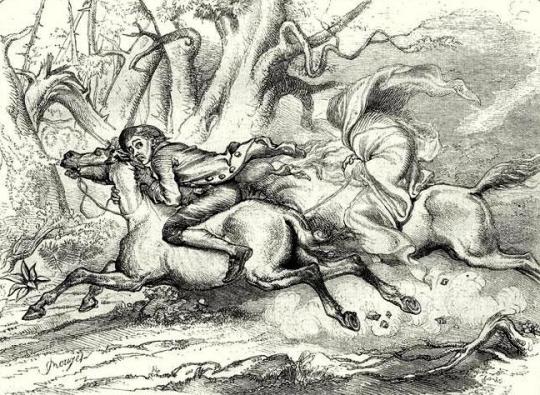




CATEGORY 4: THE PARANORMAL (V)
Ghosts in Fiction
Ghosts and by extension the folklore surrounding them have always been a deep routed interest in fiction and narrative. Human instinct towards the hypnotic pull of the paranormal can be found in all major civilisations and cultures dating back millennia. The interpretation and understanding of these ghosts in popular fiction are often followed by their visual representations in the form of art. Two of the most popular and distinctive examples of this transition from narrative to visual art I researched into to explore the decisions made by the artists when creating these pieces.
The Legend of Sleepy Hollow
The two pieces of fiction in question both date back to the 19th Century. The first of which is the American speculative fiction known as ‘The Legend of Sleepy Hollow’. The short novel was wrote by American author, Washington Irvine, and has subsequently influenced a number of visual interpretations depicting scenes from the novel. The most notable scene portraying the encounter between the protagonist, Ichabod Crane and the fabled Headless Horseman.
The first image above is one of my favourite paintings, produced by American painter, John Quidor. The painting draws reference from Crane’s initial encounter with the Headless Horseman as he begins to pursue Crane. In this image, the Headless Horseman is depicted holding a pumpkin in his outstretched arm in place of a severed head. The influence of the pumpkin is persistent in many interpretations of the horseman. Often the pumpkin is placed upon the horseman’s shoulders or is held under one of his arms, as is seen in a number of contemporary cartoons such as the third image from the cartoon, ‘Scooby-Doo! and the Headless Horseman of Halloween’. The original tale however describes a severed head being carried by the horseman. The shattered pumpkin is discovered the a day later beside Crane’s own hat. Suggesting that the severed head that the horseman threw towards Crane was in fact a pumpkin which then shattered once it made contact with Crane. The use of the pumpkin is also significant in relation to American folklore and the season of Halloween when ghost tales such as this one are often recalled.
The second image portrays the headless horseman without a severed head or pumpkin on his shoulders, or held beneath one if his arms. This illustration was produced by American painter and illustrator, Felix Octavius Carr Darley, (or F.O.C. Darley) approximately thirty years after the novels initial release. Similarly to the first painting, Darley has focussed on the focal scene of the novel where the Headless Horseman pursues Ichabod Crane through the dense forest. Both images share the same subject and depict the same scene through two different mediums. The only difference between them being the inclusion of the pumpkin in the first image which is excluded from the second image.
The Headless Horseman is first and foremost considered to be a ghost. In detail, the ghost of the horseman is said to be that of a Hessian soldier who lost his head due to decapitation during the American Revolutionary War. The interpretation of this ghost in art has retained it’s appearance as described in the original novel. The Headless Horseman coincidentally has not lost any of it’s limbs to become what we often call the white-sheet ghost or a faint silhouette as is often depicted. Instead the Headless Horseman retains it’s humanoid figure, with the exception to the head of course.
A Christmas Carol
This retention of ghostly characteristics runs parallel towards the next work of fiction that I have researched for this category. A Christmas Carol, by English writer, Charles Dickens first came to the attention of the public in 1843 and has since become a fabled work of fiction bound by it’s sense of morality associated with the Christmas season. During this well known tale, the self-centred character of Scrooge is visited by three ghosts during the night: The Ghost of Christmas Past, the Ghost of Christmas Present, and the Ghost of Christmas yet to Come (Future).
These three ghosts have been popular in their interpretations throughout a number of films and art works over the years, often changing slightly in aesthetics to match the film, cartoon, or art work’s portrayal. The ghosts’ image is more or less fixed however and generally translated correctly from piece to piece. The fourth, fifth, and sixth images above all represent illustrative scenes depicting Scrooge with each of the three ghosts throughout the course of the night.
It is apparent in more contemporary interpretations of the three ghosts that each ghosts lends itself to various portrayals and interpretations of creatures and figures related to various folkloric stories and traditions across a number of cultures. The Ghost of Christmas Past draws similarities to the European conceptions of a pixie or fairy. This ghost is often drawn in a style that matches these mythical creatures aesthetically which is further emphasised by the ghost’s gender. The Ghost of Christmas Present draws influences from Father Christmas and Mother Nature. This ghost is described and later portrayed as being very large in size, brandishing fruitful and green items often associated with Mother Nature. He is usually depicted wearing green as described in the novel and is often portrayed as being jolly in nature, two original aesthetic traits of the original Father Christmas. The third and final ghost, The Ghost of Christmas yet to Come perhaps is most symbolic in it’s reference to the Grim Reaper. This ghost is often portrayed as a malevolent phantom dressed in a dark cloak that completely covers his face.
The ghosts of Dickens’ ‘A Christmas Carol’, unlike common ghosts interpretations, are kept alive in their appearance through their symbolic description in the novel. Subsequent interpretations of these ghosts across a number of films and art works portray each of the ghosts using the same formula as the one originally described by Dickens himself.
It appears that ghosts present in the work of fiction are more likely to retain their original appearances than ghosts who are believed to have been seen in haunted locations when reproduced into a visual format. This may be in turn due to the role of fiction and it’s ability to entice a wide audience. Whereas eye witness accounts of ghosts, although still popular, do not imprint on the memory as effectively.
Image Sources:
https://en.wikipedia.org/wiki/The_Legend_of_Sleepy_Hollow
http://cdn.static.ovimg.com/episode/129271
https://www.awesomestories.com/images/user/521f066e78b81219d2766686a2dcfd57.jpg
http://www.victorianweb.org/art/illustration/eytinge/42.jpg
http://3.bp.blogspot.com/-iUfK1a43qlk/UrmgH-Ci7qI/AAAAAAAADiI/8_xZkAsk_xE/s1600/Eytinge.lastspirit.jpg
2 notes
·
View notes
Photo
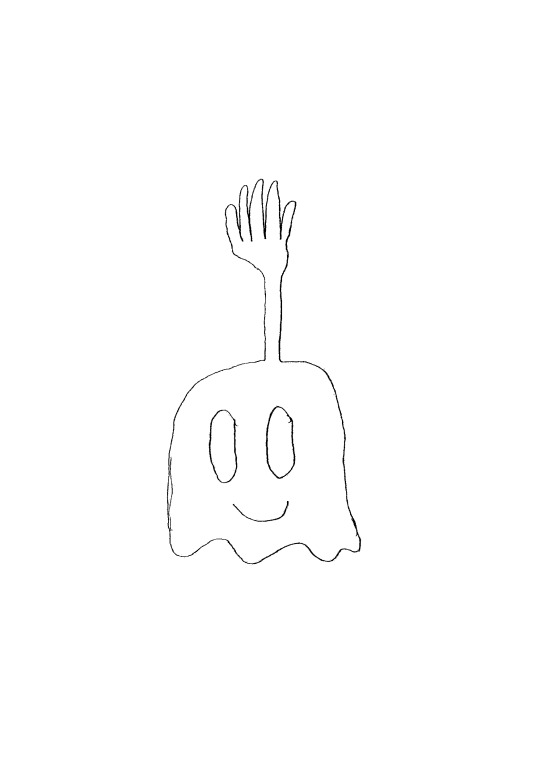
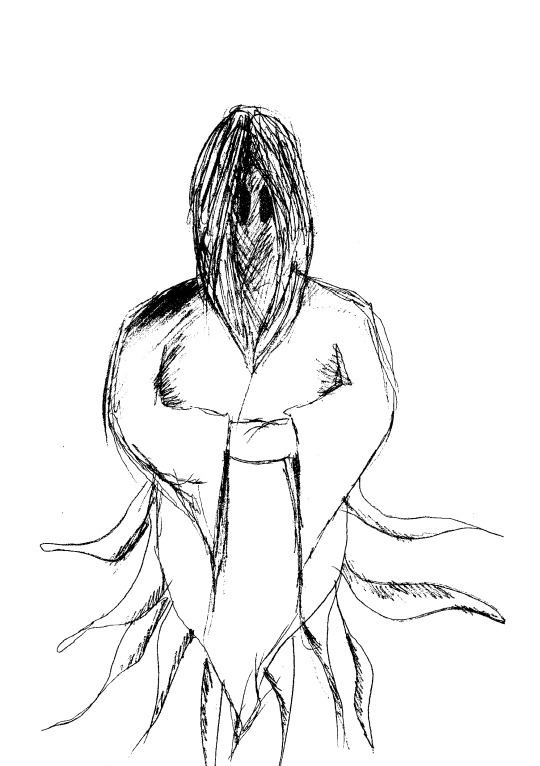
CATEGORY 4: THE PARANORMAL (IV)
Draw What You Imagine!
Having researched into the two distinctive types of ghosts, I decided to set my family the challenge of drawing what they believe a ghost would look like. The two images above coincidentally represent two very different interpretations. The first image represents a white sheet ghost in appearance, more specifically drawing reference from a cartoon character. It is apparent in this depiction that the symbolism of a character has solely influenced the portrayal of a ghost to the extent where subjects characteristic’s have been included into the drawing, the notable example being the hand outstretching from the ghost’s head.
The second image bears resemblance to a historical interpretation of a ghost that focuses mainly on the human form. When asked about the thought process behind this piece, the artist stated that they wished for their interpretation to incorporate mysterious and anonymous features into a human-like character.
It is interesting to note that neither of the above pieces represent a human dressed in ordinary clothing as ghost encounters often elaborate. When drawing the unknown in the form of ghosts, it is clear that both of these drawings lend their aesthetic qualities to stereotypical natures associated with a ghost. The first being a literal translation of a cartoon character and the second drawing inspiration from a ghost’s malevolent and ominous nature.
1 note
·
View note
Photo
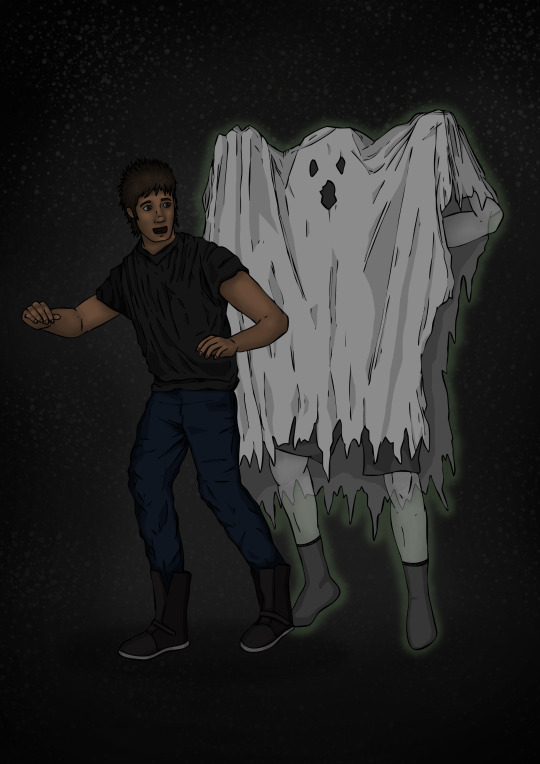
CATEGORY 4: THE PARANORMAL (III)
The Ghost Within
The image above represents my interpretation of a ghost interacting with the living. I chose to merge the two distinctive ideologies of a ghost to create this image, in essence creating a ghost wearing a Halloween ghost costume. I chose to interpret the ghost in this way due to a question that I often hear circulating amongst friends and family.
How would you know, or by contrary, not know whether you have seen a ghost before?
If ghosts are in fact meant to resemble a person as they were before death, then it could be possible to bear witness to a ghost without realising that you have done so. Film, narrative, and art have all explored this question in great depth to question what you may think you see. It’s an interesting theory non the less.
The character in the image above believes that he is seeing a friend dressed in a ghost costume, yet he is completely unaware that he is in fact witnessing the activity of a ghost.
0 notes
Text
WHAT I HAVE LEARNT
CATEGORY 3: FOLKLORE
Folklore is an area of history and contemporary culture that has continued to fascinate the minds of those enticed my its mysterious traditions for centuries and even millennia. Art has benefited greatly from these written and oral accounts, producing a number of pieces depicting strange and mysterious creatures thought to be encountered only under the rarest of conditions. Thus providing an insight into a deeper part of human interaction shrouded in secrets and myths.
Art that has derived form folkloric accounts in contemporary years has developed in style to gain a wider artist interpretation. Whilst still retaining features from their original designs as described in the traditional teaching of folklore, the common interpretations of the vampire and the werewolf, for example, have extended beyond their original descriptions. Interpretations of these creatures appear more fluid in modern art works, often designed to favour their given audience.
After researching into the pseudo-science of Cryptozoology, it would appear that this area of interest is open to, and often encourages artist interpretation whenever drawings and paintings are produced. Although a standard definition for each cryptid often exists, interpretations of these secret animals vary from design to design. A possible explanation for this variation may lie with the photo ‘evidence*’ produced by various sightings and encounters. These photographs and descriptions of the supposed, same cryptid can often contradict one another aesthetically. Whilst a number of photographs claim to give existence to the same creature, their capture’s often reveal only parts of the cryptid. Leaving what remains open to artist interpretation. This ideology is supported by the ‘Surgeon’s Photograph**’ which depicts a small portion of the Loch Ness Monster emerging from beneath the water. A number of concepts and designs of the Loch Ness Monster have emerged over the past half a century, some depicting a dinosaur like creature, whilst others elaborate on the tube like appearance of the creature.
When comparing this category to the previous two categories, it is by no surprise that this category depends more on artist interpretation than the other two. Extinct animals will often draw their influences from science and its recordings of fossils, whereas descriptions of a given subject will often try to rely solely on the description being given. In my opinion I believe that this choice is made as a result of the mysterious nature of folklore. Unlike science, folklore is not always objective and is often receptive to opinion. This is often reflected in subsequent art produced which offers an insight into a world that exists within our own that we do not see.
*placed within inverted commas as no/or little concrete evidence exists to support or otherwise contradict these claims.
**which is now believed to be hoax.
0 notes